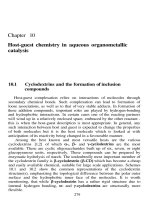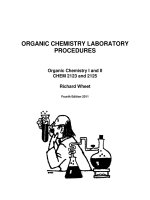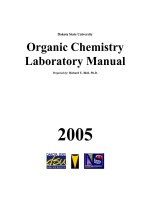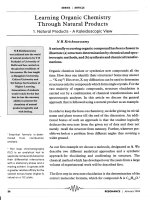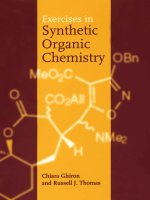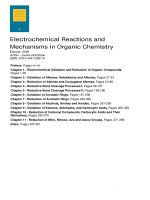Exercises in Synthetic Organic Chemistry pdf
Bạn đang xem bản rút gọn của tài liệu. Xem và tải ngay bản đầy đủ của tài liệu tại đây (4.39 MB, 135 trang )
Exercises
in
Synthetic
Organic Chemistry
Exercises
in
Synthetic
Organic
Chemistry
CHIARA
GHIRON
and
RUSSELL
J.
THOMAS
Department
of
Medicinal Chemistry,
Glaxo Wellcome
S.p.A.
Verona,
Italy
OXFORD
NEW
YORK TOKYO
OXFORD
UNIVERSITY
PRESS
1997
Oxford
University Press, Great Clarendon
Street,
Oxford
OX2 6DP
Oxford
New
York
Athens
Auckland Bangkok Bombay Buenos Aires
Calcutta
Cape
Town
Dares
Salaam Delhi Florence Hong Kong
Istanbul Karachi Kuala Lumpur Madras Madrid Melbourne
Mexico City Nairobi Paris Singapore
Taipei
Tokyo Toronto
and
associated companies
in
Berlin Ibadan
Oxford
is a
trade mark
of
Oxford
University Press
Published
in the
United
States
by
Oxford
University Press Inc.,
New
York
©
Chiara Ghiron
and
Russell
J.
Thomas, 1997
All
rights reserved.
No
part
of
this publication
may be
reproduced,
stored
in a
retrieval system,
or
transmitted,
in any
form
or by any
means, without
the
prior permission
in
writing
of
Oxford
University
Press. Within
the UK,
exceptions
are
allowed
in
respect
of
any
fair
dealing
for the
purpose
of
research
or
private study,
or
criticism
or
review,
as
permitted
under
the
Copyright, Designs
and
Patents Act, 1988,
or
in
the
case
of
reprographic
reproduction
in
accordance with
the
terms
of
licences
issued
by the
Copyright Licensing Agency. Enquiries concerning
reproduction
outside those terms
and in
other countries should
be
sent
to
the
Rights Department,
Oxford
University Press,
at the
address above.
This
book
is
sold subject
to the
condition that
it
shall not,
by way of
trade
or
otherwise,
be
lent, re-sold, hired out,
or
otherwise
circulated
without
the
publisher's prior consent
in any
form
of
binding
or
cover other than that
in
which
it is
published
and
without
a
similar
condition
including this condition being imposed
on
the
subsequent purchaser.
A
catalogue
record
for
this book
is
available from
the
British Library
Library
of
Congress Cataloging
in
Publication Data
(Data available)
ISBN
0 19
855944
5
(Hbk)
ISBN
019
855943
7
(Pbk)
Typeset
by the
authors
Printed
in
Great Britain
by
Butler
&
Tanner Ltd,
Frome, Somerset
This
book
is
dedicated
to our
families
Preface
The
advent
of
ever-more
sophisticated
methods
of
information retrieval
is
revolutionising
the
way
chemists work.
The
possibility
of
accessing
a
database which,
in a
matter
of
seconds,
is
capable
of
providing hundreds
of
methods
of
carrying
out a
synthetic transformation means
that
the
time
in
which
a
synthetic strategy
can be
planned
is
reduced enormously.
A
subtle,
but no
less profound
effect
of
this completely
new
approach
is in the way
chemists
handle
the
'vocabulary'
of
their profession,
a
knowledge
of
possible chemical transforma-
tions.
It
could
be
said that
it
will
become less important
to
memorise
lists
of
synthetic meth-
ods,
but
this creates
a
problem. Computer reaction databases
are
only
as
good
as the
questions
we ask
them,
and
without
a
sound knowledge
of
what
is
chemically
feasible,
we
can-
not
construct
a
query
to
obtain
the
exact reaction conditions
we
need.
Undoubtedly
one of the
most powerful tools
for the
design
of a
synthesis
is the
elegant con-
cept
of
retrosynthesis.
By
looking
at the
target structure,
and
having
the
knowledge
of how
each
of the
functional
groups,
and
some
of the
carbon-carbon
bonds, present
in the
molecule
could
be
introduced,
it is
possible
to
dissect
the
target, taking
it
back
to
potential starting
materials. This concept again relies
on the
chemist having
a
large enough vocabulary
of
trans-
formations
to
hand.
One of the
best ways
of
increasing
a
person's
knowledge
of the
chemical transformations
available
is to
spend time analysing published syntheses.
By
following
a
molecule through
the
various transformations
to the final
product
it is
possible
to
observe,
in
complex
real-life
sit-
uations,
the
application
of
synthetic methods.
An
even more
effective
approach
is to
study
an
article
in the
form
of a
synthetic exercise, either
for
informal discussion
in a
group,
or
private
study.
This
has the
benefit
of
encouraging
the
chemist
or
student
to
reflect
for a
while
on
pos-
sible mechanisms, reaction conditions,
and the
stereochemical outcome without having
the
answer immediately
to
hand.
An
additional
benefit,
over simply studying
an
article
from
the
literature,
is
that
in
some
way
it
removes
the
choice
of
topic. This
may be
important bearing
in
mind
the
natural ten-
dency
of
many
of us to
study areas that
we
already know something about, thus reducing
the
learning curve. This book
has
therefore deliberately chosen examples
from
a
wide range
of
synthetic
targets.
The
purpose
of
this book
is to
provide chemists with
a
collection
of
exercises constructed
from
the
recent literature.
The
exercises
are
designed
to try and
provide people
at
various lev-
els
with synthetic challenges,
from
final
year undergraduates
to
graduate students
and
more
experienced post-doctoral chemists. Thus
in a
group consisting
of final
year undergraduate
students, post-graduate research students,
and
more experienced post-doctorate
and
acade-
mic
staff
members,
the
less experienced members
can
learn about
the
more fundamental
organic transformations, protecting
group
strategies
and
stereochemical considerations,
while
the
more senior chemists have
the
possibility
to
analyse
the
more detailed mechanistic
aspects,
while
having
the
opportunity
to
revise
and
discuss
the
basic concepts.
We
hope that this text proves
useful
both
in
academic
and
industrial chemistry depart-
ments,
and may
provide
the
basis
for
productive group discussions
of
synthetic problems.
We
shall always
be
pleased
to
receive comments
and
suggestions
from
readers
as to how we can
improve
on the
concept
for
future
volumes.
Verona
C. G.
October
1996
R. J. T.
The
Authors
Chiara Ghiron
was
born
in
Geneva, Italy
in
1965. Having read chemistry
at The
University
of
Geneva between 1985
and
1990
she
joined Glaxo Wellcome
in
Verona, where
she is
cur-
rently
a
member
of the
Medicinal Chemistry Department.
Russell
J.
Thomas
was
born
in
Swansea, Wales
in
1966,
and
read
chemistry
at the
University
of
Kent
at
Canterbury between 1984
and
1987. Having completed
his
Ph.D. with
Prof. Stan Roberts
at the
University
of
Exeter
in
1990,
he
moved
to
Verona
in
Italy
to
work
for
Glaxo Wellcome
in the
Medicinal Chemistry Department.
Acknowledgements
The
authors would like
to
thank Phil Cox,
Sylvie
Gehanne, Fabrizio Micheli,
and
Maria
Elvira
Tranquillini
for
help
in
proof-reading
the
exercises. Thanks also
to
Daniele Donati,
Tino Rossi,
and
Melissa Levitt
for
encouragement
and
helpful
suggestions,
and to the
staff
at
OUP for
their support
of the
project
at its
various stages.
The
authors would also like
to
acknowledge
Glaxo Wellcome S.p.A.
for
granting permission
to
undertake
the
writing
of
this
book.
Contents
List
of
Abbreviations
xiii
Introduction
1
1.
Total
Synthesis
of
(-)-Ovatolide
3
2.
Total Synthesis
of
RS-15385
4
3.
Total Synthesis
of
Islandic Acid
I
Methyl Ester
5
4.
Total Synthesis
of
(+)-PatulolideC
6
5.
Asymmetric Synthesis
of
l-Deoxy-8,8a-di-epi-castanospermine
8
6.
Synthesis
of a
Structure Related
to
Hydantocidin
9
7.
Total Synthesis
of
Cryptophycin
C 10
8.
Total
Synthesis
of
(±)-Leuhistin
12
9. The
Asymmetric Synthesis
of
Bryostatin Fragments
13
10. The
Total Synthesis
of
(-)-Balanol
14
11.
Approach
to the
Synthesis
of
Pseudopterosins
16
12.
Total Synthesis
of
Neodolabellenol
17
13.
Total Synthesis
of
(-)-Swainsonine
18
14.
Total
Synthesis
of
Octalactins
A and B 19
15.
Asymmetric Synthesis
of the
Milbemycin
B
3
Spiroketal Subunit
20
16.
Stereoselective Total Synthesis
of
(+)-Artemisinin
22
17. The
Synthesis
of
(±)-Prosopinine
24
18.
Synthesis
of a
Protected Fluorocarbocyclic Nucleoside
25
19.
Synthesis
of
Tropane Alkaloid Calystegine
A3 26
20. The
Synthesis
of
(±)-Oxerine
28
21.
Synthesis
of an
Enantiopure
C-4
Functionalised 2-Iodocyclohexanone Acetal
29
22.
Total Synthesis
of
(-)-Solavetivone
30
23.
Total
Synthesis
of
(+)-Himbacine
32
24.
Synthesis
of
5-Hydroxytiagabine
34
25. An
Approach
to
Zoanthamine Alkaloids
35
26.
Total Synthesis
of
1233A
36
27.
Synthesis
of a Key
Intermediate
of
13-Methylcarbapenem Antibiotics
38
28.
Total
Synthesis
of the
Enantiomer
of
Hennoxazole
A 40
29.
Total Synthesis
of
(+)-Duocarmycin
A 41
30.
Studies Towards
the
Total Synthesis
of
Rapamycin
42
31.
Studies Towards
the
Total Synthesis
of
Rapamycin
44
32.
Studies Towards
the
Total Synthesis
of
Rapamycin
46
33.
Synthesis
of
Isochromanquinones
47
34. The
Synthesis
of
(±)-12a-Deoxytetracycline
48
35.
Synthesis
of a
D-c/z/ro-Inositol
1
-Phosphate
50
36.
Stereoselective Synthesis
of
(±)-Aromaticin
51
37.
Synthesis
of
7-Methoxycyclopropamitosene
52
38.
Total Synthesis
of
(+)-y-Lycorane
53
39.
Enantioselective Total Synthesis
of
(-)-7-Deacetoxyalcyonin Acetate
54
40.
Total Synthesis
of
(+)-Tetrahydrocerulenin
56
Contents
41.
Total Synthesis
of
(+)-Longifolene
57
42.
Studies toward
the
Total Synthesis
of
Cerorubenic
Acid-Ill
58
43.
Total Synthesis
of
10-Decarboxyquinocarcin
60
44.
Total Synthesis
of
(+)-Pyripyropene
A 62
45.
Total Synthesis
of
d,/-Isospongiadiol
63
46.
Total Synthesis
of the
Stemona Alkaloid
(-)-Stenine
64
47.
Total Synthesis
of
(-)-Papuamine
65
48.
Total Synthesis
of
(+)-Stoechospermol
66
49.
Synthesis
of the
Tricarbonyl Subunit
C8-C19
of
Rapamycin
68
50.
Synthesis
of the AB
Ring Moiety
of
Ciguatoxin
70
51.
Total Synthesis
of
(+)-Carbonolide
B 72
52.
Approach Towards
the
Asteriscanolide Skeleton
74
53.
Total Synthesis
of
(+)-Dolabellatrienone
75
54.
Total Synthesis
of
Stenine
76
55.
Synthesis
of
3B-Acetoxydrimenin
78
56. The
Total Synthesis
of
(+)-Adrenosterone
79
57.
Total Synthesis
of
(-)-Suaveoline
80
58.
Total Synthesis
of
(+)-7-Deoxypancratistatin
82
59.
Enantioselective Synthesis
of
Deoxynojirimycin
84
60.
Formal Synthesis
of
(±)-Aphidicolin
85
61.
Synthetic
Efforts
Towards Bruceantin
86
62.
Total Synthesis
of
(+)-FR900482
88
63.
Total Synthesis
of
(3Z)-Dactomelyne
90
64.
Total Synthesis
of
(±)-Acerosolide
92
65.
Synthesis
of a
Vindorosine Precursor
93
66.
Synthesis
of
(-)-PGE
2
Methyl Ester
94
67.
Total Synthesis
of
(-)-Parviflorin
96
68.
Total
Synthesis
of
(-)-Chlorothricolide
98
69.
Synthetic Studies
on
Furanoheliangolides
100
70.
Total Synthesis
of
Staurosporine
102
71.
Total Synthesis
of
(-)-Cephalotaxine
104
72. The
Synthesis
of
Picrotoxinin
106
73.
Total Synthesis
of
(+)-Dactylol
107
74.
Synthesis
of
(±)-Ceratopicanol
108
75.
Total Synthesis
of
(±)-MyrocinC
110
76.
Synthesis
of
Staurosporine Aglycon
112
77.
Synthesis
of
(205)-Camptothecin
113
78.
Synthesis
of a
Fragment
of
(+)-Codaphniphylline
114
79. The
Total Synthesis
of
Indanomycin
116
80. A
Total Synthesis
of
Taxol
118
81.
Total Synthesis
of
(-)-Grayanotoxin
III 120
82.
Enantioselective Total Synthesis
of
(-)-Strychnine
122
Xii
Common Abbreviations
Used
in the
Text
AD
Asymmetric dihydroxylation
AE
Asymmetric
epoxidation
AIBN
a,a'-Azowobutyronitrile
Aldrithiol® 2,2'-Dipyridyldisulphide
All
Allyl
Alloc Allyloxycarbonyl
9-BBN
9-Borabicyclononane
BMS
Borane-methylsulphide complex
BINAP 2,2'-Bis(diphenylphosphino)-1,1 '-binaphthyl
BINAPO Phosphinous acid, diphenyl-[l,r-binaphthalene]-2-2'-diyl ester
Boc terf-Butoxycarbonyl
BOM
Benzyloxymethyl
BOP-C1 Bis(2-oxo-3-oxazolidinyl)phosphinic chloride
Bn
Benzyl
BTAF Benzyltrimethylammonium
fluoride
Bz
Benzoyl
BHT terf-Butylhydroxytoluene
CAN
Ceric ammonium nitrate
CBS
Corey-Bashki-Shibat
Cbz
Benzyloxycarbonyl
Cp
Cyclopentadienyl
mCPBA
meta-Chloroperoxybenzoic acid
CSA
Camphorsulphonic acid
DAST
Diethylaminosulphur
trifluoride
dba
Dibenzylideneacetone
DBU
1,8-Diazabicyclo[5.4.0]undec-7-ene
DCC
1,3-Dicyclohexylcarbodiimide
DDQ
2,3-Dichloro-5,6-dicyano-l ,4-benzoquinone
DEAD
Diethyl azodicarboxylate
DHP
Dihydropyran
DHQD
Dihydroquinidine
DIBAL Diisobutylaluminium hydride
DIBAL-H Diisobutylaluminium hydride
DIC
Diisopropylcarbodiimide
DMAP
4-Dimethylaminopyridine
DME
Dimethoxyethane
DMF
ATN-Dimethylformamide
DMP
Dess-Martin periodinane
DMPM
3,4-Dimethoxybenzyl
DMS
Dimethylsulphide
DMSO
Dimethylsulphoxide
DPPA
Diphenylphosphoryl azide
Common Abbreviations Used
in the
text
EE
FDPP
Fmoc
HMPA
HMPT
Ipc
KDA
KHMDS
K-Selectride®
LDA
LDEA
LiHMDS
MEM
MOM
MPM
MS
Ms
MW
NaHMDS
NBS
NMM
NMO
N-PSP
Ns
PDC
PCC
Ph
Piv
PMB
PMP
PPA
PPL
PPTS
PTSA
Pv
Py
PyBroP
SEM
SEMC1
Red-Al®
TBAF
TBDMS
TBDPS
TBS
TCDI
1-Ethoxyethyl
Pentafluorophenyl
diphenylphosphinate
9-Fluorenylmethoxycarbonyl
Hexamethylphosphoramide
Hexamethylphosphorous triamide
Isopinocampheyl
Potassium diisopropylamide
Potassium bis(trimethylsilyl)amide (KN(TMS)
2
)
Potassium tri-sec-butylborohydride
Lithium
diisopropylamide
Lithium
diethylamide
Lithium
bis(trimethylsilyl)amide (LiN(TMS)
2
)
2-Methoxyethoxymethyl
Methoxymethyl
p-Methoxybenzyl
Molecular sieves
Methanesulphonyl
Microwave
Sodium bis(trimethylsilyl)amide (NaN(TMS)
2
)
N-Bromosuccinimide
.N-Methylmorpholine
./V-Methylmorpholine N-oxide
7V"-Phenylselenophthalimide
p-Nitrophenylsulphonyl
Pyridinium
dichlorochromate
Pyridinium
chlorochromate
Phenyl
Pivaloyl
p-Methoxybenzyl
/j-Methoxyphenyl
Polyphosphoric acid
Porcine pancreatic lipase
Pyridinium
p-toluenesulphonate
/j-Toluenesulphonic acid
Pivaloyl
Pyridine
Bromotripyrrolidinophosphonium hexafluorophosphate
[2-(Trimethylsilyl)methyl
[2-(Trimethylsilyl)ethoxy]methyl
chloride
Sodium
bis(2-methoxyethoxy)aluminium hydride
Tetrabutylammonium
fluoride
terf-Butyldimethylsilyl
tert-Butyldiphenylsilyl
terf-Butyldimethylsilyl
Thiocarbonyl diimidazole
xiv
Tf
TFA
TFAA
THP
TIPS
TMG
TMS
TMSCI
TMSOTf
Tol
o-Tolyl
TPAP
Tr
Troc
Ts
p-TsOH
Vitride®
Z
Common Abbreviations Used
in the
text
Trifluoromethanesulphonyl
Trifluoroacetic
acid
Trifluoroacetic
anhydride
Tetrahydropyranyl
Triisopropylsilyl
Tetramethylguanidine
Trimethylsilyl
Trimethylsilyl
chloride
Trimethylsilyl
trifluoromethanesulphonate
p-Toluyl
o-Toluyl
Tetra-n-propylammonium perruthenate
Trityl
2,2,2-Trichloroethoxycarbonyl
p-Toluenesulphonyl
p-Toluenesulphonic acid
Sodium bis(2-methoxyethoxy)aluminium hydride
Benzyloxycarbonyl
xv
Introduction
The
purpose
of the
book
The
exercises
in
this book
are
intended
to
provide
challenges
for
people
with
various
levels
of
experience.
A
final year undergraduate student should obviously
not be
expected
to
tackle
a
problem without
the aid of his or her
favourite textbooks,
and
will
still
undoubtedly have
difficulty
with
the
more advanced problems.
The
advanced
aspects
of an
exercise
are
intended
for a
more experienced chemist
to
analyse
and
discuss
in
detail.
A
student will hopefully
find
that
in
studying
the
exercises,
while
at
first
it
will
be
difficult
to
complete even half
of the
questions unaided, with time both
the
size
of his or her
'vocabulary
1
of
reactions
and the
time necessary
to
study
an
exercise
will change dramatically.
How
an
exercise
is
constructed
The
problems
are
taken
from
recent publications either
of
total syntheses
of
natural
products,
or the
syntheses
of
related systems.
The
answers
to the
various questions
are
not
provided
in
this book, although they
can
easily
be
obtained
from
the
original
articles. This
was
done
not
only
to
reduce
the
size
of the
text,
but
also
to
allow study
and
discussion
of a
problem
in at
least
a
formal
situation
of not
knowing
the
answer.
Seeing
a
reaction
in
which
an
olefin
is
transformed into
a
1,2-diol with osmium
tetroxide
is a
useful
way of
learning chemistry,
but not
nearly
as
effective
has
having
time
to
think
of
what
the
reagent
or
product could
be
before
seeing
the
solution.
The
article,
or
articles
from
which
the
exercise
was
taken
is
cited immediately
below
the
title.
In the
schemes, some
of the
structures
or
reaction conditions
(in
bold
letters)
are
missing.
At the end of the
scheme there
are
some additional discussion
points, where additional questions regarding mechanism, choice
of
reagents,
stereochemistry, stereoselectivity etc.
are
listed. Below
the
discussion points there
are
usually
some additional articles
and
reviews
for
further
reading
on key
topics covered
in
the
exercise.
These references
are
usually
not
cited
in the
original paper.
In
order
to
construct
a
coherent exercise,
it was
necessary
to
change
the
molecule
and
reaction
numbering
used
in the
original publication.
Although
it is a
very subjective choice,
the
exercises
are
ordered
in an
approximately
ascending order
of
difficulty.
While obviously there
can be no
absolute
guarantees,
a
final
year
undergraduate
or
more junior postgraduate student
is
advised
to
start
at the
front
and
work
through
the
book
from
there.
In
many cases
the
target molecules have been synthesised
by
several
research
groups
around
the
world
with
quite
differing
approaches.
Our
choice
of
which article
to
use in
this book should
not be
considered
as a
measure
of
which approach
is
more valid
or
innovative,
the
choice
was
made simply
on the
basis
of how the
syntheses
offered
Introduction
themes
to be
explored
in
this book. Similarly,
we do not
intend that articles chosen
for
exercises
appearing
at the
start
of the
book should
be
considered
in any way
less
innovative than those chosen
for
more
difficult
exercises towards
the
back. Clearly
the
difficulty
of an
exercise
largely depends
on the
amount
of
information provided
or
omitted.
How
to
approach
an
exercise
As
this book
is
intended
for
chemists with
a
wide range
of
experience, there
is no
single
best
way of
approaching
an
exercise. However, possibly
the
most effective
way for
everyone
is to
first
try and
complete
as
much
as
possible unaided before going back
over
the
more problematic parts with
the
help
of
additional textbooks
and
discussion
with
colleagues. Having completed
these
first
two
passes,
a
final check
of
both
the
answered
and
unanswered problems
can be
made with
the
help
of the
original article.
It
is not too
surprising
how
obvious most
of the
reactions become with
the aid of the
original text
to
hand when studying
an
exercise!
An
additional benefit
of not
consulting
the
original paper
until
the end is
that
it
gives
the
possibility
of
proposing alternative
approaches
to
those used, which
can
then
be
discussed with colleagues.
In
cases
where
an
unknown
structure cannot
be
deduced
from
the
reagents used
to
form
it, a
useful alternative
is to
look
at the
next structure
in the
synthetic
sequence
and
go
backwards, using
a
form
of
retrosynthetic analysis based
on the
reagents necessary
to
arrive
at the
known structure.
An
important concept
for the
less
experienced chemists
is
that
we
would
be
very
surprised
if
someone (other
than
the
authors
of the
original journal
article!)
were
able
to
complete
all of the
questions exactly. With time
and
experience,
the
number
of
unanswered questions will decrease notably, although
hopefully
it
will never arrive
at
zero.
1.
Total Synthesis
of
(-)-Ovatolide
A.
Delgado
and J.
Clardy,
J.
Org. Chem., 1993,
55,
2862.
11
Abstracted
with permission
from
J.
Org.
Chem.,
1993,58,
2862
©1993
American Chemical Society
Discussion
Points
•
What other isomer
is
formed
in the
nitration step
a?
•
Rationalise
the
regioselectivity
of the
mono-debenzylation reaction carried
out
in
step
b.
•
Suggest
a
structure
for
compound
6 and
give reasons
for
carrying
out the
reaction
in a
reductive environment.
•
What
is the
mechanism
of the
hydrolysis
of
compound
8?
•
Give
an
explanation
for the use of
ethylenediamine
in
step
1.
Further
Reading
• For a
review
on
diastereoselective nitroaldol reaction,
see:
D.
Seebach,
A. K.
Beck,
T.
Mukhopadhyay
and E.
Thomas, Helv. Chim.
Acta,
1982,
65,
1101.
For a
modification
of the
nitroaldol reaction using
alumina,
see:
G.
Rosini,
E.
Marotta,
P.
Righi
and J. P.
Seerden,
J.
Org.
Chem.,
1991,
56,
6258.
2.
Total Synthesis
of
RS-15385
J. C.
Rohloff,
N. H.
Dyson,
J. O.
Gardner,
T. V.
Alfredson,
M. L.
Sparacino
and J.
Robinson III,
J.
Org. Chem.,
1993,58,
1935.
Abstracted
with
permission
from
J.
Org. Chem., 1993,58, 1935 ©1993 American Chemical Society
Discussion
Points
•
What
is the
mechanism
of the
Bischler-Napieralski
reaction
of
step
b?
•
Suggest
a
reason
why
less
hindered
bases
could
not be
used
in
step
f.
•
Propose structures
for the
minor diastereomers obtained during
the
hydrogenation step
g.
•
Suggest
a
derivatising agent
for the
HPLC analysis
of the
optical purity
of
the
10-camphorsulphonic acid salt obtained
in
step
h.
Further
Reading
• For
reviews
on
isoquinoline alkaloids synthesis, see:
M. D.
Rozwadowska, Heterocycles,
1994,39,
903;
E. D. Cox and J. M.
Cook,
Chem. Rev., 1995,
95,
1797.
• For a
review
on
chiral derivatising agents, see:
Y.
Zhou,
P.
Luan,
L. Liu
and
Z P. Sun,
J.
Chromatogr.
B:
Biomed. AppL, 1994, 659, 109.
3.
Total Synthesis
of
Islandic Acid
I
Methyl Ester
T.
Shimizu,
S.
Hiranuma,
T.
Watanabe
and M.
Kirihara, Heterocycles,
1994,38,243.
Abstracted
with permission
from
Heterocycles, 1994,38,
243
©1994
The
Japan Institute
of
Heterocyclic Chemistry
Discussion Points
• The
sequence
from
2 to 3
introduces
a
tetrahydropyranyl (THP) group.
What
is the
mechanism
of
this step?
•
Following
step
d a
quantity
of
compound
9 was
isolable.
Suggest
a
mechanism
for its
formation.
O OMe
OSEM
Give
two
alternative methods
of
removing
a SEM
group
as in
step
j.
4.
Total Synthesis
of
(+)-Patulolide
C
S.
Takano,
T.
Murakami,
K.
Sainizu
and K.
Ogasawara, Heterocydes,
1994,39,
67.
Abstracted
with
permission
from
Heterocydes, 1994,39,
67
©1994
The
Japan
Institute
of
Heterocyclic
Chemistry
4.
Total Synthesis
of
(+)-Patulolide
C
Discussion
Points
•
What
is the
mechanism
of
steps
b and k?
•
Give
a
method
for the
formation
of the
Z-olefin
14
from
alkyne
9.
Further Reading
• A
similar approach
to
that described above
was
used
by the
authors
in the
synthesis
of a
milbemycin
K
fragment,
see:
S.
Takano,
Y.
Sekiguchi
and
K.
Ogasawara, Heterocycles, 1994,
38, 59.
• For an
excellent review
on the
two-directional chain synthesis strategy
see:
C. S.
Poss
and S. L.
Schreiber, Acc. Chem. Res.,
1994,27,
9.
Another
elegant application
of
this strategy
to the
synthesis
of
(-)-parviflorin
has
recently
been
published:
T. R.
Hoye
and Z. Ye, J. Am.
Chem. Soc.,
1996,118,
1801.
• For a
review
of
macrocyclic
ring
formation
methods see:
Q. C.
Meng
and
M.
Hesse
in
Top. Curr. Chem., 1992,161, 107.
• A
more recent chemoenzymatic synthesis
of the
related (/?)-patulolide
A
has
also been published:
A.
Sharma,
S.
Sankaranarayanan
and S.
Chattopadhyay,
J.
Org. Chem., 1996,
61,
1814.
5.
Asymmetric Synthesis
of
l-Deoxy-8,8a-di-epi-
castanospermine
S.
F.
Martin, H J. Chen
and V. M.
Lynch,
J.
Org. Chem., 1995,
60,
276.
Abstracted
with permission
from
J.
Org. Chem., 1995,
60, 276
©1995
American Chemical Society
Discussion Points
•
Explain
the
stereoselectivity obtained
in
step
a.
•
Propose
a
mechanism
for the
conversion
of 2
into
3.
•
Suggest
a
structure
for the
intermediate
formed
in
step
j.
Further Reading
• For
oxidative opening
of
furans,
see:
B. M.
Adger,
C.
Barrett,
J.
Brennan,
M. A.
McKervey
and R. W.
Murray,
J.
Chem. Soc., Chem.
Commun.,
1991,21,
1553.
• For an
analysis
of
chelation-controlled carbonyl addition reactions, see:
M.
T.
Reetz, Ace. Chem. Res., 1993,
26,
462.
6.
Synthesis
of a
Structure Related
to
Hydantocidin
S.
Hanessian,
J Y. Sanceau
and P.
Chemla,
Tetrahedron,
1995,51,
6669.
Abstracted
with permission
from
Tetrahedron,
1995,57,
6669
©1995
Elsevier
Science
Ltd
Discussion
Points
•
Propose
a
mechanism
for
step
c
with
a
rationah'sation
of the
stereochemical
outcome.
•
What
is the
role
of
TBAF
in
step
i?
Further Reading
• For
recent examples
of the use of
fluoride
ion as a
base, see:
T.
Sato
and
J.
Otera,
J.
Org. Chem,,
1995,60,
2627;
see
also:
T.
Sato
and J.
Otera,
Synlett, 1995, 845.
7.
Total Synthesis
of
Cryptophycin
C
R.
A.
Bairow,
T.
Hemscheidt,
J.
Liang,
S.
Paik,
R. E.
Moore
and M. A.
Tius,
J.
Am.
Chem. Soc., 1995,117, 2479.
OTBS
Abstracted
with
permission
from
J. Am.
Chem. Soc., 1995,117, 2479 ©1995 American Chemical Society
10
7.
Total
Synthesis
of
Cryptophycin
C
HO
12
u.
morpholine,
Pd(Ph
3
)
4
,THF
NHBOC
13
Ph
v.
9,
DCC, DMAP,
CH
2C12
w.
x.
y.
FDPP,
'Pr
2
NEt,
DMF
OMe
Discussion
Points
•
Suggest
a
synthesis
for
compound
1.
•
Explain
the
regioselectivity
in the
epoxide opening
of
step
c.
• A
considerable amount
of
compound
15 was
formed when step
e was
carried
out in the
absence
of
2,2-dimethoxypropane.
15
Suggest
an
explanation
for the
formation
of
this compound
and the
function
of
2,2-dimethoxypropane.
•
Give mechanisms
for
steps
h and u.
Further
Reading
• For
studies
on the
regioselectivity
in
epoxide opening, see:
M.
Chini,
P.
Crotti,
L. A.
Flippin,
C.
Gardelli,
E.
Giovani,
F.
Macchia,
M.
Pineschi,
J.
Org. Chem., 1993,
58,
1221;
M.
Chini,
P.
Crotti,
C.
Gardelli
and F.
Macchia, Tetrahedron, 1994,
JO,
1261.
• For a
review
on
ring-closure methods
hi the
synthesis
of
natural products,
see:
Q. C.
Meng
and M.
Hesse, Top. Curr. Chem.,
1992,161,
107.
• For a
modification
of the
allyl group removal procedure, see:
A.
Merzouk
and
F.
Guibe,
Tetrahedron
Lett., 1992,
33,
477.
11
8.
Total Synthesis
of
(±)-Leuhistin
S.
J.
Hecker
and K. M.
Werner,
J.
Org. Chem., 1993,58, 1762.
O
OEt
b.
(PhCO)
2
O, NaH, C
6
H
6
c. ?,
NaOEt,
EtOH
O
HO,C
A
OH
Abstracted with permission
from
J.
Org. Chem.,
1993,58,
1762
©1993
American Chemical Society
Discussion Points
•
Suggest
a
possible reason
for the
selectivity observed
in
step
e.
•
Explain
the
migration
of the
benzoate group observed
in
transforming
compound
4
into
5.
Further
Reading
• For the use of
activated alumina
in the
synthesis
of
3-oxoesters,
see:
D. D.
Dhavale,
P. N.
Patil
and R. S.
Raghao,
J.
Chem. Res., Synop., 1994,4,
152.
• For
reviews
on
catalytic
transfer
hydrogenation, see:
R. A.
Johnstone,
A.
H.
Wilby
and I. D.
Entwistle, Chem. Rev., 1985,
85,
129;
G.
Brieger
and
T. J.
Nestrick, Chem. Rev., 1974,
74,
567.
12
9. The
Asymmetric Synthesis
of
Bryostatin Fragments
J. De
Brabander
and M.
Vandewalle, Synthesis, 1994, 855.
O
i-BuO
11
Abstracted
with
permission
from
Synthesis,
1994,
85S
©1994
Georg
Thieme
Verlag
Discussion Points
•
What
is the
purpose
of the
magnesium bromide etherate
in
step
d?
•
Propose
an
explanation
for the
observed stereochemical outcome
of
step
g-
•
Explain
the
role
of the
Seyferth
reagent
in the
formation
of
product
6.
What
is the
mechanism
of
this step?
13
